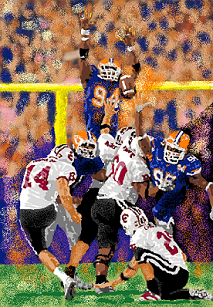1)
Florida 13-1
2) Ohio State 12-1
3) Louisiana State 11-2
4) Southern Cal 11-2
5) Boise State 13-0
6) Louisville 12-1
7) Wisconsin
12-1
8) Michigan 11-2
9) Auburn 11-2
10) West Virginia 11-2
11) Oklahoma 11-3
12)
Rutgers 11-2
13) Texas 10-3
14) California 10-3
15) Arkansas 10-4
16) Brigham Young 11-2
17) Notre Dame 10-3
18) Wake Forest 11-3
19) Virginia Tech 10-3
20) Boston College 10-3
21) Oregon State 10-4
22) Texas
Christian 11-2
23) Georgia
9-4
24) Penn State 9-4
25) Tennessee 9-4
This was the toughest top 25 to fix yet. It involved lengthy bouts of pondering and a whole lot of squinting. There are always a few gray areas: potential fixes that are somewhere between being logically necessary and not. But this top 25 had more gray areas than the others so far.
However, it also had some of the easiest no-brainer fixes yet. Like Arkansas. The teams they lost to were all ranked #7 and higher. They defeated #9 and #25. So where should they be ranked? Not #15, I can assure you that.
Then there's Michigan, who lost only to #2 and #4, and defeated #7. Yet they are ranked #8. Sound right to you? No, not to me either. I mean, it's possible that that could be a logically valid ranking. But very, very unlikely.

My painting of the 2006 play of the year: Florida's Jarvis Moss blocks South Carolina's last-second field goal attempt to preserve the 17-16 win and save us all from watching Ohio State replay Michigan in the national championship game. Looks a whole lot like the 2009 play of the year...
